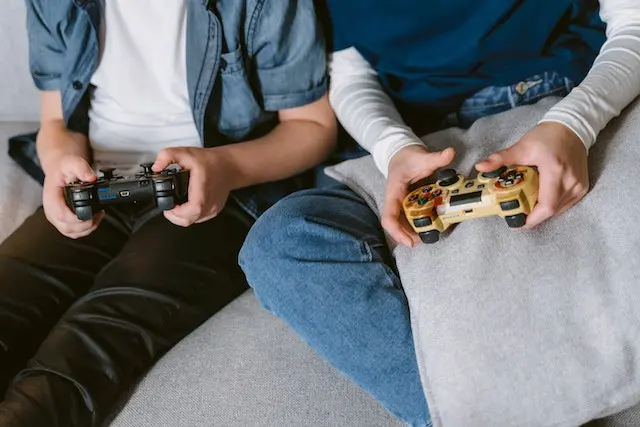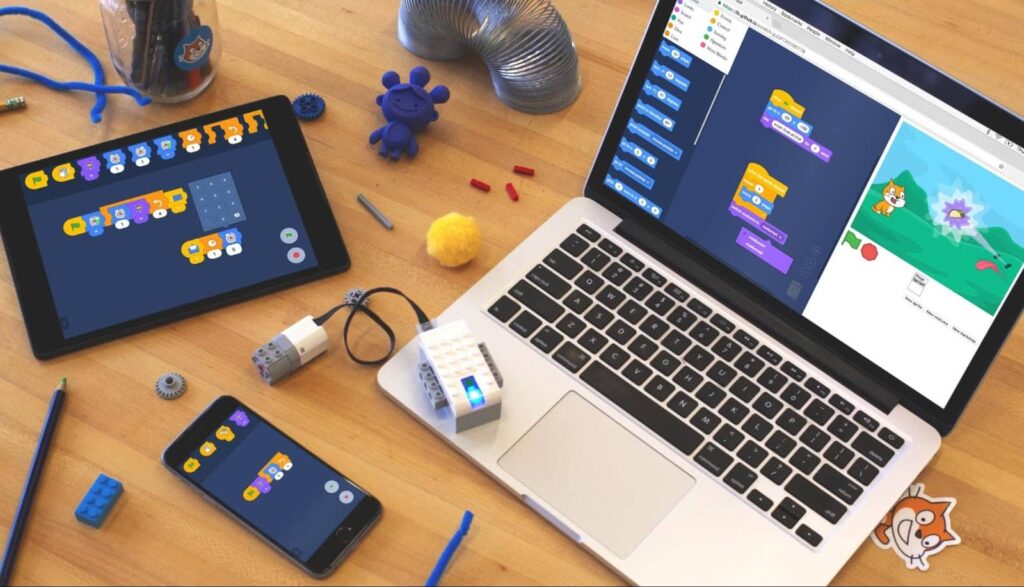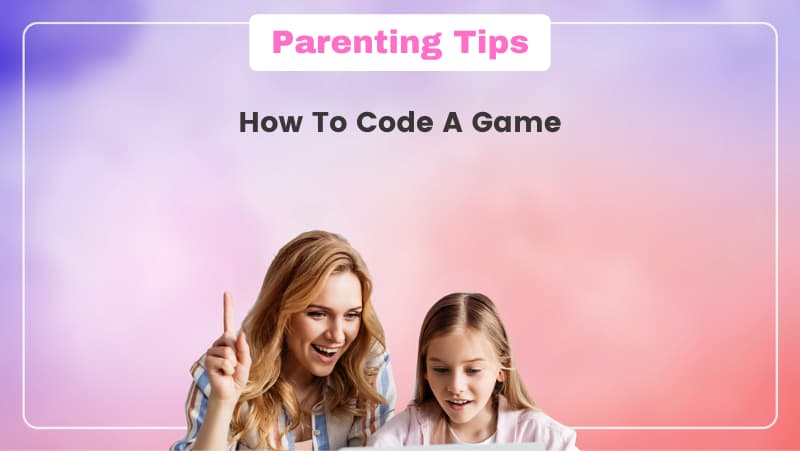Who doesn’t like to play games and have some fun to refresh our minds? We all enjoy playing games in our spare time, whether they are physical or digital.
And in the last decade, since technology has become an inseparable part of our daily lives, we are no strangers to digital games.
Children and adults alike have experienced playing games at least once in their lives. And each time we play a video game, we sometimes wonder, “What if… what happens if it is like this or that?”
From this curiosity comes the next question: How to code a game? Is it possible for children to create and code a game by themselves?

Well, the answer is yes. It is possible because coding a new game or coding, in general, is not rocket science. It’s quite easy, and coding and developing a new game can be just as fun as playing them.
Imagine the sense of accomplishment that you felt once you were able to create a fun custom game to share with your friends and they kept playing it because they loved it. And it just started with a bit of code.
Table of contents
Where Do I Start to Code Games?
There are many programming languages available, so deciding which one is best for kids to learn on how to code a game may be intimidating. However, there is no need to worry because we have already provided a list of some of those programming languages.
- Code.org
Code.org, one of the block-based coding platforms for early-age coders, is a good place for children to learn how to create games in its Game Lab. This platform is completely free to use. Kids simply need to drag and drop the programs using the interface’s vibrant block-based design; they do not need to be concerned about the syntax.
In Code.org’s Game Lab, children can make simple animations and games with objects and characters that interact with each other. They may use their creativity to create the project and begin coding using blocks. 2
- Scratch
Another free-to-use block-based coding tool that is quite popular among kids is Scratch programming. Available in more than 70 languages, the codes are quite simple and easy to understand. Even beginners will be able to create simple games on the first try since there’s a tutorial video on the platform itself.
Aside from creating your personalized game, you can also explore game projects by other people, play them, and see the code that is used to build those games.

- HTML
Together with CSS, HTML is well known for creating a website. But, you can also create online games using this programming language.
In the earlier days and older versions of HTML, we had to use Adobe Flash Player to run online games or any multi-media content. However, we no longer need Flash Player if we use HTML5 and JavaScript. In HTML5, there’s <canvas> element that is perfect for making games.
- JavaScript
When applied to HTML documents, JavaScript enables dynamic interactivity on websites. As a result, it is a fantastic option for creating online games that can be played on both Personal Computers and mobile devices. Due to its versatility, this programming language is also very well-liked for learning.
Mobile games are undoubtedly growing increasingly popular as smartphones become more common. Given this, utilizing JavaScript to create a game is an excellent choice.
- Python
As one of the high-level languages, Python is still as popular as usual. Well-known as one of the easiest programming languages to learn out there, Python is quite fast for automating small, repetitive tasks.
Therefore, Python is an excellent choice to make smaller games, though it is possible to create larger ones as well.
To make it easier for programmers, Python already has a PyGame library that is specifically used for building a game.
Types of Games Kids Can Code
Before you jump right into creating your game project, please note that different programming languages will create several types of games.
You can look at them below before taking the next step.
- Web-Based Games
Our very first category of games is online. If they have an Internet connection, everyone on the planet can simply access it. Web-based games are one of the easiest to code even for beginners since there are some block-based coding platforms like Code.org or Scratch that allow them to create and share their creations with almost no hassle.
- Mobile Games
Since all people around the world use and carry smartphones nowadays, it can be said that this type of game has the greatest potential audience.
So, you can consider creating a mobile game if you want a wide range of users and the greatest audience.

- Computer Games
According to Wikipedia, a computer game, usually referred to as a PC game, is a video game played on a personal computer (PC) as compared to a video game console or arcade machine. Computer games are second in terms of user popularity. Its defining characteristics include more diverse and user-determined gaming hardware and software and greater capacity in input, processing, video, and audio output.
- Console Games
Video games that are playable on Xbox and PlayStation belong to the console games category. The popularity of Xbox and PlayStation among players is only ranked #3, despite being designed solely to play video games.
Step by Step Guide on How to Code a Game
After understanding the available options for programming languages to code a game as well as the types of games, the next process is game designing, with the steps below:
- Plan and Choose Your Type of Game
- Add your game’s visual
- Write down the Logic/Algorithm of your game
- Start to Code
- Test and Debug The Game
- Publish, Share, and Play It With Your Friends
Plan and Choose Your Type of Game
When a project is planned, a work path is created to be followed as it progresses. You must put your project concept in writing as soon as you have one for your personal use as a guide. Finally, just add any further details. You receive your initial design version.
You need to decide what sort of game you want to make once you have your basic idea for the project and have carefully laid out your strategy.
This includes thinking about the general theme of the game; what is the game type? Is it single-player or multiplayer? What do(es) the player(s) do? Winning or losing condition, etc.

Add Your Game’s Visuals
The game’s visuals or graphics encompass everything that the player can see on the screen. including background setting, main characters, and any other objects like tools, weapons, enemies, coins, etc.
Decide the Logic or Algorithm of the Game.
The algorithm is a crucial step before you begin to code. For your scripts to work properly afterward, you must lay down the game logic as accurately as you can.
For example, the starting point, how the player will move, what will happen when colliding with other objects, etc. This algorithm will act as a guideline for your codes.
Start to Code
Now you can have some fun by writing lines of code to bring your game to life. Sometimes this process can be quite overwhelming, and you might not know where to start. It’s helpful to break it down into smaller pieces and begin with the easier parts, such as coding the player’s movement. If you’re looking for guidance, online coding classes for kids can provide a structured, step-by-step approach to learning how to code and build your own games.
You might be able to write all the code yourself from scratch, or you could need to employ a game engine that draws its code from bigger code libraries. It all depends on how complicated your game is.
What is a Game Engine?
A game engine is a setting that enables developers to create video games of all sizes for usage on various consoles and gadgets. Without having to write any code, this game engine enables you to incorporate several features such as collision management, animations, artificial intelligence, and much more.
It can be said that game engines are collections of code libraries that can be used to create games with far less manual coding. Thus, using them is going to save you a lot of time and effort, especially if the game that you want to create is much more complex than it would be if you coded it manually.
Test and Debug the Game
Drumroll please, it is the decisive moment! After you spent so much of your precious time writing line after line of codes, now is the time to test it out to make sure that everything works fine and exactly as it was intended to.
Push the game to its limit; test every aspect of the game, not only in the ideal and proper way to play it but also by giving some bad input or colliding with some objects that are not supposed to.
If something is not working right, it is time to debug, find, and fix the problems. Otherwise, your game is good to go.
Publish, Share, and Play!
Congratulations! You have finished the game! Now you can release your game into the wild, make it public, and enjoy the result of your hard work by playing it with your friends. Exploring computer programs for kids can provide structured learning to create and release games, fostering creativity and accomplishment.
Conclusion
It is possible to create games on our own because there are numerous simple and easy programming languages available. The thing is, we need to know what kind of games we are trying to create and, of course, keep learning and practicing.
The computer games for kids provide entertainment and educational experiences.
However, starting the journey of creating your own game with coding can be overwhelming and intimidating at times. Therefore, BrightChamps is here for you. BrightChamps can help you learn how to code a game with its live interactive classes supported by professional, experienced coding educators from all over the world.
With its specially designed international standard curriculum for students in Grades 1–12, BrightChamps opens the opportunity for your children to learn how to code a game and develop their IT skills to prepare for their future.
To get your hands on more such articles, educational content, and free resources on coding for kids, robotics courses for kids, game development, etc., check out the BrightCHAMPS Blog Page now!
Frequently Asked Questions (FAQs)
Not really, as it all depends on the size of the project itself.
You can code a game by yourself if you only want to make a small, simple game. But if you want to create such a huge, complicated game and commercialize it, then it is better to work with a professional team.
Yes, it is.
You can still code everything by yourself, be it a simple game or a complex one. But please remember that it will take more time.
Yes, it is, but there is a catch. You need to officially become a Scratcher first, which stands for a registered Scratch user who has already shared at least 2 projects as well as meeting the other requirements to be promoted.
And, please note that multiplayer Scratch games can only be played among Scratchers as well. So, unregistered users or inexperienced users without Scratcher status, unfortunately, will not be able to play the multiplayer game.













